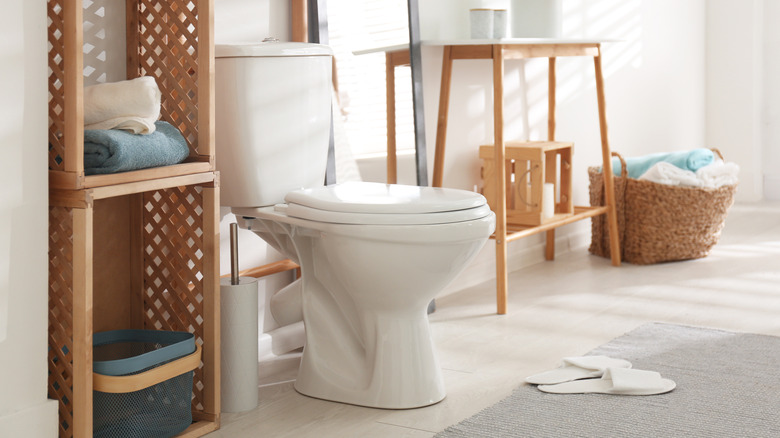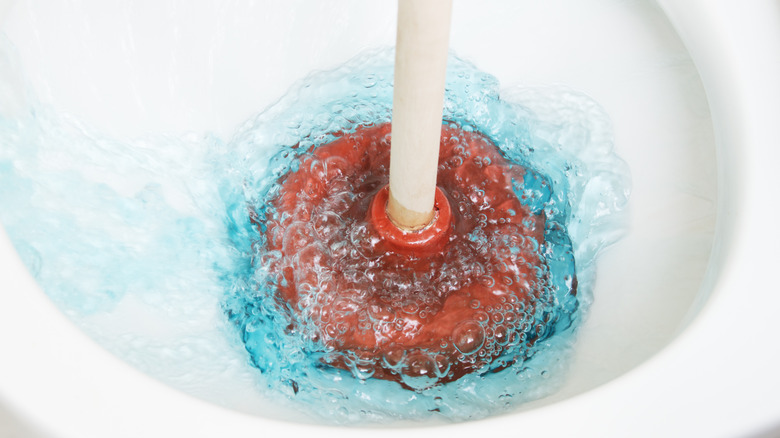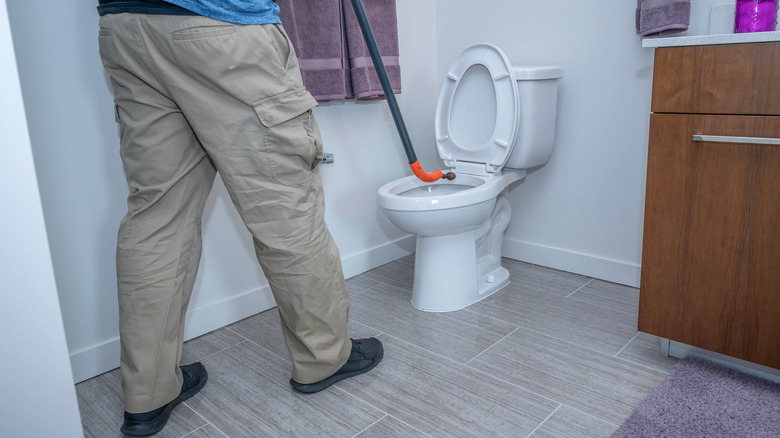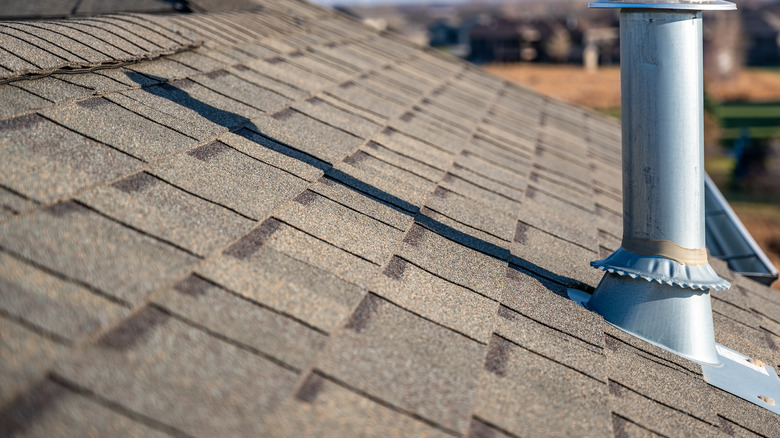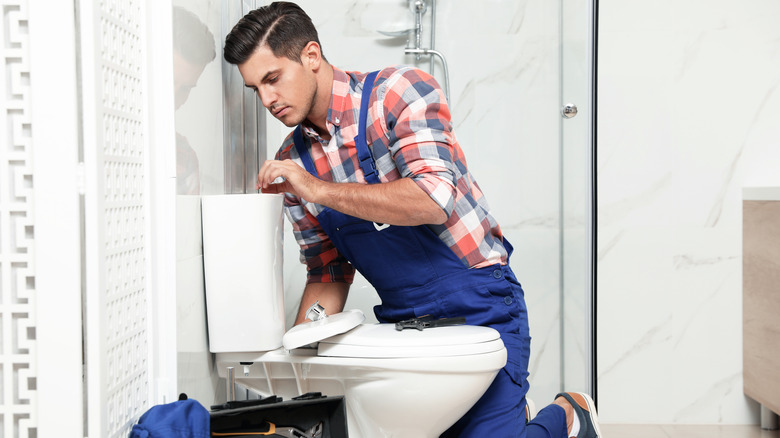The Real Reason Your Toilet Is Gurgling
The curious noise invades your household. It's that part gurgle, part bubbling sound your toilet makes at random times for no fathomable cause. If you're worried that the trickling from the bathroom might indicate a bigger problem than water splash, you might be right. A toilet at rest should stay silent.
So what's the problem? A babbling latrine is in reality letting you know that something is happening in the drain line. When everything works properly, air moves easily in the line and waste goes throughout the passage without trouble. Those air bubble sounds emphasize that some sort of abnormal suction is occurring. Negative air pressure builds and pushes air back into the toilet. Thus, you will hear the unwelcome sounds that goes with that process. The pressure can at times become so great that toilet can even flush itself (via Bob Vila).
This means that somewhere the drain system is clogged, according to Bob Vila, either in the main sewer line or in the vent pipe of your home. Worst case scenario: It's a broken line that could worsen without attention and back up not just the toilet, but even your shower or tub. Best case scenario: a DIY unclogging mission. Either way, you should not ignore the noise. Keep in mind, too, that sometimes, toilets get old. If your commode is from the '90s, it probably clogs more frequently, and maybe it's time to get a new one entirely.
DIY method #1: Plunge the toilet
Before going the DIY route, you'll also want to talk to your neighbors and see if the same sound is happening to them. This could mean there is a sewer issue, according to House Trick. If that's the case, call your municipal sewer authority, and tell them what's happening in your home or neighborhood. If you're the only house that is experiencing the problem, though, there are a few things you can do to address the issue.
If a clogged drainpipe is making the gurgling, plunging the toilet can help the issue, as per Homelyville. But only if the clog is a small one — for instance, someone flushed a bunch of tissues into the toilet, and it became lodged in the drainpipe.
A problem like this is easily solved. To start, though, you need to seal all the drains in the bathroom's sink, shower, or bathtub. Fastening duct tape to the seals of the fixtures will heighten the plunger's impact since often these things all run on the same drain line, and you want the pressure focused on eliminating the clog (via Bob Vila). Place the plunger into the toilet, press firmly to the drain area, and suction it to the toilet. You'll use about 10 to 15 vigorous pushes up and down. Then, listen carefully. Is the toilet still making sounds? If not, then voila — your repair is done! If not, you'll need to try other methods (via Broadleys).
DIY method #2: Snake the drain
Stubborn clogs require stronger methods. A handy tool for removing wedged material is a plumber's snake — aka a sewer snake. This tool has a cable with a head that contains blades to literally break through those tougher clogs. A snake either uses a motor or a hand-operated crank. Either version can be inserted into the toilet bowl to eliminate the problem. The head usually moves between five to 15 feet down the drain, depending on its cable size, and hopefully digs out whatever is wedged inside. For a longer cable, some motorized models allow a 100+ foot reach (via Bob Vila). These heads can be larger, so you might need to remove the toilet and put the tool right into the floor's drainpipe.
If the clog is hidden deep into the sewer line, you may need to leave the bathroom, and find the sewer clean-out to fix the problem. Find where the main sewer line runs from your house by looking in the basement or crawlspace. Look for a pipe with a PVC cap, which can be placed just above the ground or slightly below it, which might mean some digging. Remove the cap with a wrench, and snake the sewer line. Plumb Times cautioned that waste sometimes comes out of the opening, so back away from the site slightly as you loosen the cap. Then listen to your bathroom. If the sound stopped, you fixed it.
DIY method #3: Clean the vent stack
Ever notice that uncapped air pipe up on your roof? A vent stack helps balance air pressure, according to This Old House. This helps the waste in your drainpipes move easily through the system, and can become clogged with leaves, debris, or ice and, sometimes, small animals can even get stuck there. This hurts your tub and sink's ability to drain, and can cause that gurgling noise coming from your toilet.
Whether you snake the drain in your home first or try your luck with the stack first is up to you. But this fix-it method requires a visit to the roof — something you might not feel comfortable doing yourself. (And, if that's the case, you should definitely hire professionals to check the vent stack for you.)
First, use a flashlight to check the vent — anything wedged within eight to 10 feet into the pipe should be evident. If you can't reach the vent easily, use a rope and some duct tape to secure the flashlight and shine the light into the vent stack. Pull minor problems out with a wire coat hanger that's been straightened. More aggressive blockages might require a blast from a garden hose, which will remove it with the water's force and push it into the sewer (via Bob Vila).
Time to call the experts
Sometimes, a problem has no DIY solution. Then, it's time to call in the experts — and that means a phone call to the plumber. After all, as The Spruce pointed out, the plumbing in your house is an intricate system, and, sometimes, trying to fix something may only lead to more unintended repairs. So tell them what you have done so far, and they can take it a step further.
Plumbers usually have special small cameras that can fit into your vent stack for closer views into the pipe. They also use super-powerful sewer snakes that can even go through tree roots. They'll let you know what's going on and how to fix it. If your main sewer line is the problem, they will let you know and can even make recommendations on where to go next if they can't fix the issue themselves (via Mr. Rooter).
Most likely, though, a toilet gurgle is something they can handle, and soon enough, your home will have its usual peaceful sounds back — that is, until the next situation arises. But fingers crossed, this will be your last repair for awhile!
